#self-sovereign identity
Text
The Digital Identity Dilemma: SSI vs. SBT

In the ever-evolving digital world, the way we manage our digital identities is becoming a hot topic. I've been diving deep into the realms of Self-Sovereign Identity (SSI) and Soulbound Tokens (SBT) and stumbled upon a super insightful blog that shed light on why SSI might just be the better option for managing digital credentials. Let's unpack this together.
Self-Sovereign Identity (SSI): Your Digital Autonomy
SSI is all about putting you in the driver's seat of your digital identity. It's a decentralized approach that lets individuals control their personal data. Imagine having a digital wallet where you store all your credentials, and you get to decide who sees what. It's like being the gatekeeper of your own digital castle.
Soulbound Tokens (SBT): The Blockchain's Promise
On the flip side, SBTs are like digital badges of honor that are permanently attached to your blockchain identity. They represent your credentials, achievements, and affiliations in a non-transferable way. Think of them as tattoos for your digital soul—once you have them, they're there for good.
Why I'm Leaning Towards SSI
Control and Privacy
With SSI, your data is yours, and yours alone. You have complete control over who gets access to your credentials. It's a privacy advocate's dream come true, offering a level of security and autonomy that's hard to beat.
Flexibility and Interoperability
SSI doesn't tie you down to any single platform or blockchain. It's designed to work across various systems, making your digital identity as versatile and adaptable as you are.
The Power to Update
Life changes, and so do our credentials. SSI allows you to easily update or revoke your digital credentials, ensuring your digital identity remains as dynamic as your real-life one.
Broad Adoption Potential
SSI's open and flexible nature means it can be adopted across a wide range of sectors and industries. It's not just a niche blockchain solution but a comprehensive approach to digital identity management.
Wrapping It Up
After exploring both sides, I'm convinced that SSI offers a more holistic and user-friendly approach to managing our digital selves. The autonomy, privacy, and flexibility it provides align perfectly with the digital age's demands.
For those curious to dive deeper into this comparison, I highly recommend checking out this neutral and informative blog: explore here. It's a great read that offers a detailed look into the pros and cons of each approach.
So, what do you think? Is the future of digital identity in the hands of SSI, or do SBTs have a role to play in shaping our digital worlds? Let's chat in the comments!
Remember, as we navigate through the digital cosmos, the way we manage our identities is crucial. Whether it's SSI, SBT, or another emerging technology, the goal is to find a solution that respects our privacy, autonomy, and need for control. Here's to a future where our digital identities are as secure and authentic as our real-world ones.
0 notes
Text
Unraveling the intricate concept of self-sovereign identity. Delve into the core principles, exploring how individuals can control and manage their digital identities autonomously. Understand the transformative power of self-sovereign identity, deciphering its benefits in privacy, security, and user empowerment. This comprehensive exploration provides a nuanced understanding of the evolving landscape of digital identity, shedding light on the revolutionary shifts in control and ownership.
0 notes
Text
Simple Truths: The Case for Self-Sovereign Identity
The world moves. Technology advances. We find ourselves standing at crossroads, staring at paths paved by Big Gov and Big Tech. Both promise the same thing: a digital ID for the new age. But the truth? It’s found somewhere else – in Self-Sovereign Identity (SSI). Here’s why.
Big Gov has strength. It has power. But with that power comes weight. The heavy bureaucracy makes change slow, like an old…

View On WordPress
0 notes
Text

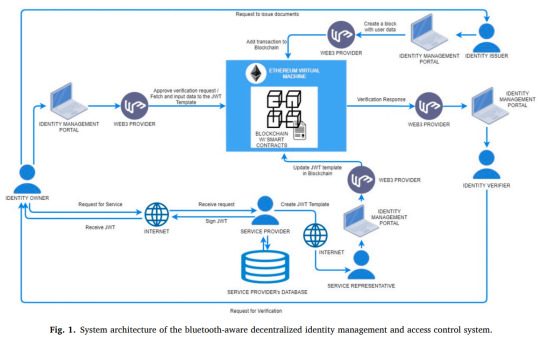


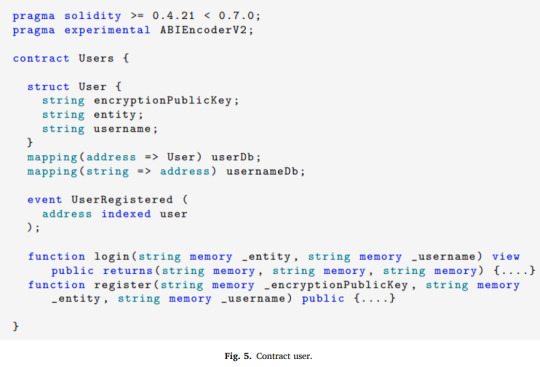
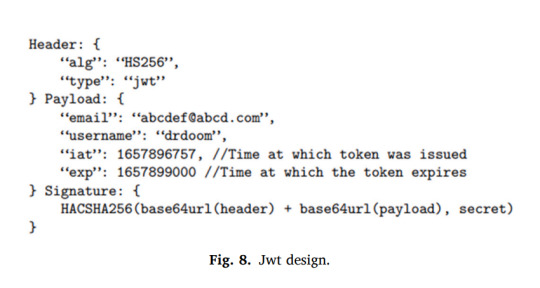

Elsevier's "Measurement: Sensors" Vol. 31, 17 Jan. 2024, DOI: 10.1016/j.measen.2024.101032
Blockchain aware IDMS with access control. Self-sovereign identity (SSI) with single sign-on facilitated through JWT tokens and Ethereum's smart contracts.
Read more: https://www.sciencedirect.com/science/article/pii/S2665917424000084
#blockchain#digital identity#ethereum#decentralization#web3.js#ecdsa#SSI#self sovereign identity#proof of work
0 notes
Text
Within Your Eyes Intro Post
DEMO [Last Updated June 22nd, 2024]
You are a Warden, a monster hunter who has come to the Kingdom of Auris which has become the forefront runner in it’s acceptance of magic and supernatural alike within the West Highlands. But when strange happenstances occur, you are called upon not just because of skill, but also because of your condition. A condition you’ve lied about for last 12 years.
Unearth the secrets that magic holds as a new form is discovered.
Befriend or romance those who attempt to worm through the cracks of the mask you wear. Or will you fight to keep them at arms length?
Regardless of where your journey takes you, your feathered friend will be at your side. As he always has been.

This story will be 18+ for the following reasons:
Explicit and erotic intimate scenes
Death, including of a child
Violence, blood and gore
Thoughts of suicide
Mentions of suicide
Self harm
Explicit language
Mental trauma
Horror elements
Feelings of being watched
NOTE: Your character will be pretending to have a disability (blindness), not because of a disorder but out of self preservation.
This list may be updated.

You are running away from your past. As you take a this new job, you're forced to confront it. What vices do you use to cope? Will you learn to rely on others or will your raven be your only source of comfort? Will you feel guilty for your lies? Yours will be a journey of self-forgiveness, or maybe you'll only fall deeper into despair.
Play as a man, woman, or non-binary. Gay, straight, or bi.
Plenty of customization options from physical appearance to clothes.

Φ Admos de Le Wren ─ Male | Draconian | Second-Born
Admos, the Dragon Lord of Auris, ascended to the throne following a devastating conflict with his father, bypassing his older brother's claim. This decision deepened the rift among his siblings. As he enters his fifth year as sovereign, Admos grapples with guilt and uncertainty about his role in the family's discord. Will you help him find clarity or fuel his doubts?
Φ Lyth/Lyari de Le Wren ─ Gender Selectable | Draconian | Tenth-Born
Ly took on the role of Viceroy/Vicereine in Auris and became their brother Admos's Right Hand, playing a vital part in the kingdom's recovery after a conflict with their father. However, an incident they triggered over a year and a half ago almost led to another war, casting doubt on their suitability for their position and their aid to their brother. Will you help Ly grapple with their past actions and uncertainties about their role as Viceroy/Vicereine, or will their internal conflicts remain unresolved?
Φ Leese/Lea van Laere ─ Gender Selectable | Human | Vampire
Born into nobility, Lee's life as the child of prominent figures in Lenia took an unexpected turn when they were turned into a vampire. Forced to leave their home, Lee now wrestles with their new identity, desperately seeking meaning in their existence and if it's worth maintaining.
Is Lee a monster consumed by instinct, or can you help them reclaim their humanity?
Φ Xiang Xiaowen/Xiaodan ─ Gender Selectable | Human
Xiao, an ambassador dispatched to Auris to aid the Dragon Lord in Council matters, fought hard to secure their role. Serving as an unofficial advisor, they frequently share insights to assist Admos. Yet their unwavering dedication to obtaining this position hints at a deeper motivation. Perhaps they will reveal it to you.
Φ Gabriel Duarte ─ Gender Selectable | Human
Assigned to you as an assistant of sorts, the recently knighted guard is searching for their place within the Order. Perhaps their new mission will set them on a path for glory, or sink them beneath the turmoils it takes to obtain.
Φ Hestia ─ She/They | Elf? | Witch
Even the most kind have their secrets.
Φ ???
Poly Routes: Lyth/Lyari and Gabriel | Leese/Lea and Gabriel | Xiaowen/Xiaodan and Hestia
Love Triangle: Admos and ???
------------------------------------------------------------------------------
FAQ
Romance Information Post
Ko-Fi
Tumblr Asks are disabled for the time being.
------------------------------------------------------------------------------
WYE will always be free with chapters released once they are finished.
This is a planned trilogy.
Thank you for reading and for your support! ♥
#interactive fiction#within your eyes if#text based game#text based adventure#twine game#twine wip#twine interactive fiction#twine if#twine story#cyoa#interactive game#interactive novel#twine games
1K notes
·
View notes
Text
Ascent to Oblivion part 1 - airborne embrace
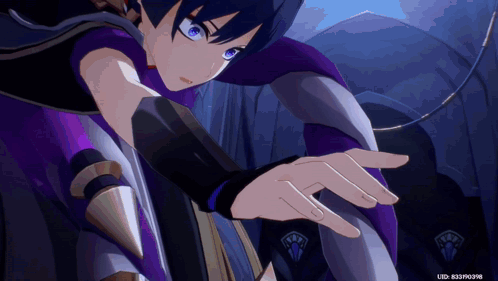

The heart imposes how one should act. How they should feel.
So how can a puppet constructed without a heart exhibit such distinct qualities?
Notes: This one is very self-indulgent. I swear I wish there was an option to catch him during this scene—
Warning: reader is not traveler btw, slight angst?

A heart is regarded as a mirror that reflects someone’s soul. A sovereign ruler that ordains decrees that the body is meant to follow.
The heart imposes how one should act. How they should feel.
So how can a puppet constructed without a heart exhibit such distinct qualities?
He doesn't have a soul, nor a heart for that matter. Yet Scaramouche doesn’t fail to display the epitome of humanity. The emotions he claims are cursed act as a substitute; an artificial heart that ushers him in the direction of the deepest desires that he sought after. It spreads within his body like a burning infection, leaving a bitter taste of rage and fury that will never be quelled. Come hell or high water, his resolve never wavers. His ambition to prove to everyone that he is destined for more perseveres. He sprints to his goal like a marathon. To conclude his journey and prove to his mother that he has always been worthy of the gnosis.
That was your understanding of the 6th Harbinger, the Balladeer.
You stand beside the Traveler, along with the Archon of Wisdom you had liberated earlier. You encounter the rising "god" of Sumeru—the existence of who you know as Scaramouche—as he presents himself as the Shouki no Kami, the Prodigal, Everlasting Lord of Arcane Wisdom. A long drawn-out battle that persisted 168 loops before you and the Traveler snatch victory from the harbinger.
You were tired and on the verge of collapsing. Bruises and scars are scattered across every nook and cranny of your skin. Yet despite everything—every word, every truth, every lie—you can't bring yourself to hate him.
You wanted to hate him.
But why couldn't you?
Was it because you felt pity? Because the solicitude of his sorrows softened the fortification encircling your heart?
Or was it because sympathized with him? Maybe you too knew how it felt when the cruel jaws of life gnaw on the strings that control destiny, only to give birth to nothing but misery and hatred toward the world?
As you looked up, you saw the electro gnosis in Nahida's possession. The puppet yells, an anguished wail of cries as every word laced with desperation begs to have the gnosis back.
"No! Anything but the gnosis!"
"That's mine!"
It was strange. Watching someone like Scaramouche throw away their pride and dignity, just for one measly gnosis. A gnosis that shaped his entire identity. An item he's been promised when he was fabricated, a promise the Raiden Shogun never kept.
Your heart throbs. Was this the one you were supposed to hate? A misguided child who grew up hating himself and everyone around him because of accidents he interpreted as his fault?
Scaramouche's slender arms extend to seize the gnosis, to grasp the adhesive that was holding up his fragmented individuality. One by one, the tubes embedded in him fracture. Pink liquid sloshed out like waves, smearing pigments on the platform. But he couldn't care less. He wanted the gnosis. He needed it. With a hushed click, your eyes widened.
He fell.
And you jumped.
Despite the burning sensation of the wounds you had accumulated from the puppet, you rise without hesitation as the overwhelming urge to catch him coursed through your veins. You create a whirlwind that propels you in his direction, with the aid of your anemo vision. Time itself decelerates as you can only hope to reach him. You were praying to any go out there that you haven't miscalculated.
One.
Your arms wrap around Scaramouche, cradling him closely to you. You caught him. Thank the archons you caught him.
Two.
You were to land swiftly on the ground—but having exerted the last of your energy—your touchdown wasn't as smooth or graceful as you had hoped. Your feet slipped, causing you and the harbinger in your arms to skid towards the rubble of rocks. Even then, you squeezed him tightly, not wanting to let go.
Three.
A deafening crash resounds in the domain as you smash into the massive debris. But your clutch doesn't waver. You held the puppet in your arms, a testament of your newfound will to protect him. To keep him safe. You could no longer watch him be cheated out of everything good. He deserves some peace, a tranquility you were willing to give. In spite of your best efforts to remain awake and asses how Scaramouche was faring, your brain started to deprive you of your consciousness.
Four.
A hand clutches your clothes firmly, as you feel the cold porcelain pressed against your skin. Before you collapse into an unconscious state, you overhear a broken sob. A sound only those with a shattered soul can let out.

Taglist for part 2 is open btw!
#genshin impact#genshin#genshin impact fanfic#scaramouche#scara fanfic#the balladeer#genshin scara#scara x reader#scara x y/n#scaramouche x reader#gender nuetral reader#genshin x reader#wanderer genshin#genshin wanderer#wanderer x reader#wanderer#wanderer x y/n#genshin impact scaramouche#genshin impact wanderer#scaramouche fanfic#wanderer fanfic#scaramouche brainrot#i just want to catch him#hoyoverse please
268 notes
·
View notes
Note
Hi! Accidentally doxxed myself upon the second request (I forget to turn on anon). Do you mind if I go anonymous again?
Requesting platonic reader as the reincarnation of the Anemo Souvereign, yet not knowing about their true identity this time! A playful, witty soul yet reserved and understanding with Venti, Neuvillette and perhaps Zhongli?
Hope you take care of yourself. I'm grateful for the work, but your health matters, too!
🌙 anon
I don't mind, who you choose to request is not my business, and that you for worrying about me 🌙 anon. Don't forget to take care of yourself because you worry about me💙

You two met before Lantern Rite
You were a child that had befriended the Melusine
They would take about you, so Neuvillette got curious
He goes with the Melusine to meet you
When he sees you he notices a few things
1. You have ears like his
2. You were using Anemo powers
3. You had no vision or gnosis
He knows only the arachons, Traveler, and dragons like him can use the elements without visions
When he approached, you became the most respectful kid ever
He asked if you knew the Traveler
Reader: "Yeah, he helped Liyue, Mondstadt, Sumeru, and us,"
He sighs, and asks if you knew the Traveler personally, you said no
He knew you weren't a god because you felt so human
When the pieces were put together, I swear he turned pale
You were a street kid so you had no idea where you came from
Neuvillette is just staring as he realized that you're the reincarnation of the Anemo dragon, a member of his family
Keeping face, he talks with you and buys you food
He decodes to adopt you, because I say so
Furina adores you and so does Neuvillette
Your playfulness makes an appearance when you and Furina are together
Loves the jokes and puns you make in an effort to make him happy
Keeps that fact that you're the reincarnation of a dragon sovereign a secret
Treats you like his child, the same way he is with Furina
Teaches you how to keep this power in check, so nothing happens to you or anyone else
Takes you with him and Furina to Lantern Rite, where you wander off causing panic in him
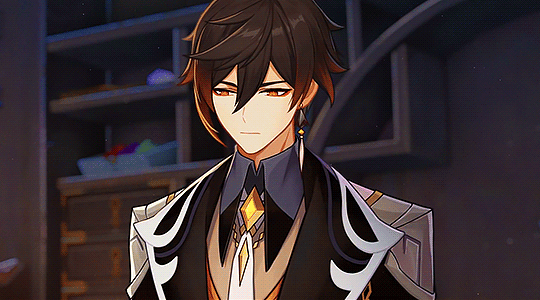
You were at Lantern Rite with Neuvillette and Furina
You wandered off and Furina found you
Zhongli was with Hu Tao who ran up to Furina
They talked business while you stood with Zhongli
He introduced himself to you and it was clear you were shy
As the four of you walked, Zhongli was telling you about Liyue
He realizes you're a dragon when Furina accidentally lets it slip
Zhongli freezes a bit but recovers
Furina says it's a joke but he knows its not
Treats you like a grandchild
You're his dragon child
Will fight Neuvillette for custody like the divorced couple they are
You now spend certain times of year in Liyue
Teaches you how to be a dragon, and tries to get you to shape shift into a dragon form
Teaches you dragon things
Finds your wit and playfulness refreshing
Has you hang out with Hu Tao for the fun or both of you
Has to send letters to Neuvillette proving your safe
Takes you to the mountains to use your powers so no one gets hurt
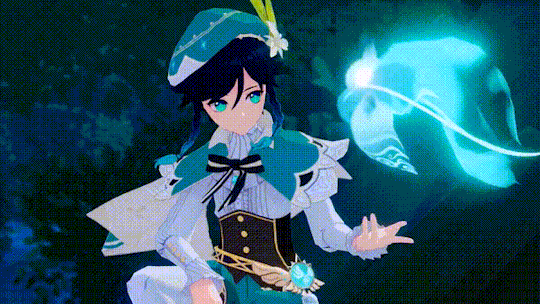
Learns about it from Zhongli
When he meets you, he brings you to Dvalin
Hopes you and Dvalin bound as dragons
Makes a lot of jokes about you being a dragon
Loves your Anemo powers
Helps you control your powers
Plays around with you
You two have battles of wit regularly
Never tells anyone about your dragon side
Is like your fun uncle
Shows you his own powers
Asks if you can turn into a dragon
If not, takes you on Dvalin rides so you can experience flying
Shows you wind gliding as well
Ingeneral, all three love you and your dragon self. The try to help you master your powers and keep you dragon identity a secret from you for your own good.
#genshin fanfic#genshin impact x reader#genshin imagines#genshin x reader#request#genshin impact#anonymous request#platonic neuvillette#Platonic Zhongli#Platonic Venti#Anemo Sovereign! Reader#Reincarnated! Reader#gn reader#Child reader
270 notes
·
View notes
Note
Please tell me more about neighbourhood PMCs in renaissance Italy
It would be my pleasure! (My research into this owes a lot to the excellent Power and Imagination: City-States in Renaissance Italy by Lauro Martines.)

The first thing to note that, unlike the condottieri, these were not private military companies. Rather, the neighborhood military companies (in the sense of a military unit, rather than a profit-making entity) were self-defense organizations formed as part of a centuries-long political struggle for control over the urban commune between the signorile (the urban chivalry)/nobilita (the urban nobility) and the populo (the guilded middle class, who claimed to speak on behalf of "the people").
This conflict followed much the same logic that had given rise to the medieval commune in the first place. Legally, the communes had started as mutual defense pacts between the signorile and the cives (the free citizens of the city) against the rural feudal nobility, which had given these groups the military and political muscle to push out the marquises and viscounts and barons and claim exclusive authority over the tax system, the judicial system, and the military.
So it made sense that, once they had vanquished their enemies and established the commune as the sovereign, both sides would use the same tactic in their struggle over which of them would rule the commune that ruled the city. The signorile and nobilita formed themselves into consorteria or "tower societies," by which ancient families allied with one another (complete with dynastic marriage alliances!) to build and garrison the towers with the knights, squires, men-at-arms, and bravi of their households. These phallic castle substitutes were incredibly formidable within the context of urban warfare, as relatively small numbers of men with crossbows could rain down hell on besiegers from the upper windows and bridges between towers, even as the poor bastards on the ground tried to force the heavy doors down below.
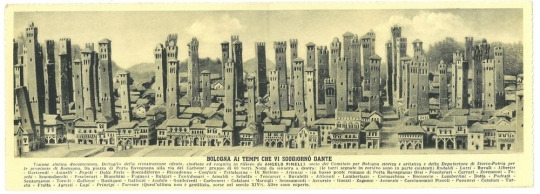
To combat noble domination of communal government, achieve direct representation on the political councils, establish equity of taxation and regulate interest rates, and enforce legal equality between nobility and citizenry, the populo formed themselves into guilds to build alliances between merchants and artisans in the same industries. However, these amateur soldiers struggled to fight on even footing with fully-trained and well-equipped professional soldiers, and the guild militias were frequently defeated.
To solve their military dilemma, the populo engaged in political coalition-building with the oldest units of the urban commune: the neighborhoods. When the cities of medieval Italy were originally founded, they had been rather decentralized transplantations of the rural villages, where before people had any conception of a city-wide collective their primary allegiance was to their neighborhood. As can still be seen in the Palio di Siena to this day, these contrade built a strong identity based on local street gangs, the parish church, their traditional heraldry, and their traditional rivalries with the stronzi in the next contrade over. And whether they were maggiori, minori, or unguilded laborers, everyone in the city was a member of their contrade.
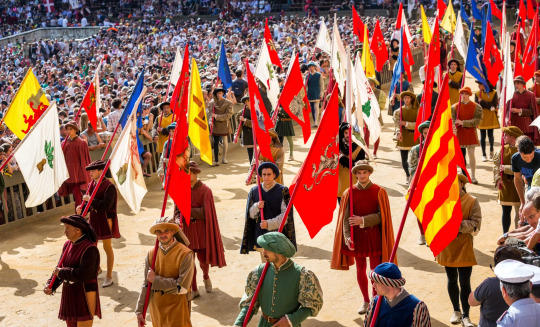
As Martines describes, the populo both recruited from (and borrowed the traditions of) the contrade to form their armed neighborhood companies into a force that would have the manpower, the discipline, and the morale to take on the consorteria:
"Every company had its distinctive banner and every house in the city was administratively under the sign of a company. A dragon, a whip, a serpent, a bull, a bounding horse, a lion, a ladder: these, in different colors and on contrasting fields, were some of the leitmotifs of the twenty different banners. They were emblazoned on individual shields and helmets. Rigorous regulations required guildsmen to keep their arms near at hand, above all in troubled times. The call to arms for the twenty companies was the ringing of a special bell, posted near the main public square. A standard-bearer, flanked by four lieutenants, was in command of each company."
To knit these companies organized by neighborhood into a single cohesive force, the lawyers' guilds within the populo created a state within a state, complete with written constitutions, guild charters, legal codes, legislative and executive councils. Under these constitutions, the populo's councils would elect a capitano del popolo, a professional soldier from outside the city who would serve as a politically-neutral commander, with a direct chain of command over the gonfaloniere and lieutenants of the neighborhood companies, to lead the populo against their noble would-be overlords.
And in commune after commune, the neighborhood companies made war against the consorteria, taking the towers one by one and turning them into fortresses of the populo. The victorious guilds turned their newly-won military might into political hegemony over the commune, stripping the nobilita of their power and privilege and forcing them either into submission or exile. Then they directed their veteran neighborhood companies outward to seize control of the rural hinterland from the feudal aristocracy, until the city had become city-state.
(Ironically, in the process, the populo gave birth to the condottieri, as the nobility who had lost their landed wealth and political power took their one remaining asset - their military training and equipment - and became professional mercenaries. But that's a story for another time...)
#history#historical analysis#renaissance history#renaissance fantasy#medieval cities#city-states#urban communes#guilds#city charters#guild charters#mercenaries#nobility#artisans#burgher rights#merchants
146 notes
·
View notes
Text
When you actually listen to the student protestors' vision, you find that it is substantively identical to that of the even more radical, violent protestors outside. To define Ashkenazim as inherently the oppressors of brown people is both bigoted and historically ignorant. To call Zionists "Babylon swine" is a slur against all Jews. To permit Jews into your encampment and allow them to celebrate Passover (a holiday about our return to the homeland of Eretz Yisrael, which ends with the words "Next year in Jerusalem") is not indicative of seeing us as equals when you also call to strip Jews as a people of the right to self-determination and self-defense. If you would see the seven million Jews of Israel expelled or fall into the clutches of a Hamas that has promised to slaughter or enslave every Jew they get their hands on, then you will ill upon the Jews. If you wish to see Jews as a vulnerable minority throughout the world, with no dedicated safe haven, in living memory of the Holocaust and the ethnic cleansing of a million Jews from the Arab world, then you wish ill upon the Jews. If you do not care what happens to the Jews of Israel if Israel is suddenly no more, then your callousness makes clear that you are no friend to the Jews. If you cannot understand why the Jews (and many non-Jews) of Israel will fight to the very last (a nuclear-tipped last, I should add) to defend Jewish self-determination in Eretz Yisrael and think a few more Oct. 7s, a few more rockets, more dead on both sides, more rejection of a sovereign Palestine within a two-state paradigm will bring about the fall of Israel, then you don't much care about the Palestinians, either.
In light of this, the Jews in that encampment look less like welcome guests than like dhimam, tolerated only so long as they accept their subject, subordinate status and praise the rulers who have power over them. Don't forget: even after accepting subjugation and onerous taxation as the price of dhimitude, the Jews of Khaibar were still expelled by their Muslim overlords. No Jew is safe depending on the beneficence of others for the simple right to live.
I appreciate Powell's article: unlike anything you read in the New York Times, where concerned Jews at Columbia are balanced by anti-Zionist Jews on a one-to-one basis, this article at least implies, meekly, that the Jews allied with the encampment are a distinct minority, and that the mainstream Jewish student body is very much on edge among their anti-Zionist peers and professors. That is a situation that should never have been allowed to happen.
40 notes
·
View notes
Text
Self-Sovereign Identity (SSI) represents a paradigm shift towards user-controlled identity verification, free from centralized authorities. Shardeum supports SSI concepts, empowering users with ownership of their digital identities through blockchain technology. Explore how Shardeum is pioneering the adoption of SSI, enhancing privacy and security in the digital age
0 notes
Text
Self-Sovereign Identity as a Business Opportunity
In the digital age, personal data has become one of the most valuable commodities. However, the traditional methods of managing digital identity have been fraught with challenges, such as data breaches, identity theft, and lack of privacy. Self-Sovereign Identity (SSI) offers a new approach to digital identity management, which gives individuals full control over their personal data. As such, it…

View On WordPress
0 notes
Note
Sorry if this is a stupid question, but could you tell us more about Åland? 😅 What even is it? Is it a country, a state/province, or something else? (sorry, I have never heard of it before joining the Hetalia fandom)
I love your art, and I would love to see more of your OCs in the future!😊
Hello, anon! Don't worry, that's not a stupid question at all! I'm willing to bet most people are in the same situation as you, so I'd love to help out.
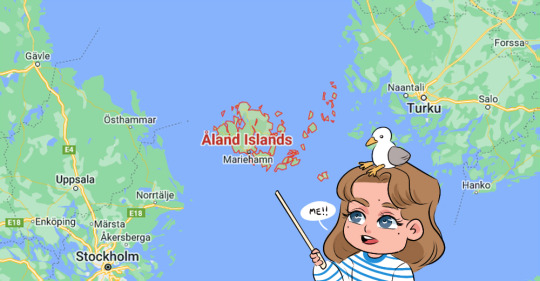
Åland Islands are an autonomous and demilitarised region of Finland. This self-governing region is made up of over 6,700 islands; only of which 65 are inhabited. In addition, there are around 20,000 smaller islands and skerries! The biggest island on the archipelago, and where 90% of the population lives, is Fasta Åland; which is only 45 km long and 55 km wide. The Åland Islands are connected to mainland Finland via the Finnish archipelago and its island clusters. But Åland's easternmost point is only 40 km away from mainland Sweden. The capital, Mariehamn, is located at an almost exact midpoint between Turku and Stockholm.
Up until the 19th century, roads were sparse, in bad shape, and thus practically useless in Nordic countries. The fastest way to transport resources, people, and information was by waterways. Thus, Åland acted as a vital connection between Sweden and Finland, especially when those two countries used to be one massive kingdom. Over the centuries, the islands developed a unique identity, shaped by the isolating harsh nature and influences from both the West and East.
Even though Åland is part of Finland, its only officially recognized language is Swedish. Since 1921, The Åland islands have had special privileges provided by the hembygdsrätt, which roughly translates to "home regional right." Simply put, a person is required to obtain this right before it's possible for them to own property on the island, vote in the local elections, or run a business - having Finnish citizenship is not enough. These rights were created to protect Ålandic identity during a time when Sweden and Finland fought over who the islands should belong to.
To be granted hembygdsrätt, certain conditions must be met; you must have Finnish citizenship, have satisfactory Swedish language skills, be registered in the Åland islands, and have lived in Åland for at least 5 years. Alternatively, if one of the parents has this right, it is also inherited by their child. However, you can also lose hembygdsrätt if you lose Finnish citizenship or live outside of Åland for more than 5 years.
Due to its location in the middle of the Baltic Sea, Åland has always been critical, and powers in the area have wanted to control it; it has been occupied by Swedes, Finns, Danes, Germans, Russians, French, and the English. This geopolitical importance is a reason why the islands have been demilitarized since the 1850s after the events of the Crimean War. Also, while Finland is a military conscription country, Ålandic men (with hembygdsrätt) are exempted from this duty.
Åland is not a sovereign country, but it has self-governing rights and its own government. Åland joined the Nordic Council in 1970 and has two representatives in it. Åland also held a separate referendum, and in 1995, it joined the EU at the same time with Sweden and Finland. Åland has a special status in the European Union, as it's considered a "third territory," meaning it's not part of the EU's value-added tax (VAT) or excise duty area.
Ålanders have a strong and separate national identity, even though they have a Finnish passport and speak Swedish as their native language. However, the separatist movement barely exists nowadays, and Ålanders generally don't see a reason to change the status quo. All the granted special laws and privileges by Finnish and international law are perhaps more helpful and prospering to this tiny island than seeking full independence.
As of December 2019, in a survey conducted by Åland Gallup, 78% of island residents supported Åland continuing to be a self-governing region of Finland. It has been a trend in gallups for decades at this point. Being part of Sweden was the least popular option, only getting 4% support, and becoming a fully integrated part of Finland got 5% of the support. 9% of respondents would support the full independence of Åland.
In a survey by the Statistics and Research Institute of Åland (ÅSUB, 2008), 90% of the respondents stated that they were Ålandic and 60% felt that they were "completely Ålandic." On the other hand, only a quarter of the respondents considered themselves "completely Finnish," and one-fifth considered themselves "Swedish at some level."
The option "European" was more popular than "Finnish," "Swedish," or "Finnish-Swedish". In the ÅSUB 2018 survey, most responders also felt a higher sense of belonging to "Nordic countries" than they did to "Finland" or "Sweden."
Another interesting statistic: In Åland Gallup's May 2019 survey, 80.4% of Åland's residents said they would support Finland, and 19.6% said they'd support Sweden if Finland and Sweden were facing each other in an ice hockey match.
I could go on about the Ålandic history and what makes its identity unique, but let this be a quick introduction to this place! Feel free to ask more if you're interested. I could have simply answered it's not a country, but I think that would leave out a lot of important context. Maybe this also explains why I think Åland should have a separate personification from Finland. I hope this helps even a little bit!
50 notes
·
View notes
Text
Stuff I Read In July 2024
bold indicates favourites
Books
Nazi Literature in the Americas, Roberto Bolaño
Antwerp, Roberto Bolaño
Parable of the Sower, Octavia Butler
Parable of the Talents, Octavia Butler
In an Abusive State, Kristin Bumiller
Short Fiction
Founding Father, Isaac Asimov
Exile to Hell, Isaac Asimov
Key Item, Isaac Asimov
Queer &c.
Science Fiction Double Feature: Trans Liberation on Twin Earth, B.R. George & R.A. Briggs [link]
King’s Member, Queen’s Body: Transsexual Surgery, Self-Demand Amputation and the Somatechnics of Sovereign Power, Susan Stryker & Nikki Sullivan
Much Ado About Nothing: Unmotivating "Gender Identity", E.M. Hernandez & Rowan Bell [link]
We Are All Nonbinary, Kadji Amin [link]
An Orientalist History of Transmisogyny, Julianna Neuhouser [link]
Where Is My Place in the World? Early Shoujo Manga Portrayals of Lesbianism, Fujimoto Yukari [link]
Alice in Monsterland, Gilles Dauvé [link]
Manchester Medieval Society: Guest Post: ‘Weaponed’ men, impotent men, and ‘not-men’: sex and manhood in Anglo-Saxon England, Chris Monk [link]
Mapping the Margins: Intersectionality, Identity Politics, and Violence against Women of Color, Kimberlé Crenshaw [link]
Man Child: A Black Lesbian Feminist’s Response, Audre Lorde [link]
Palestine
‘I’m bored, so I shoot’: The Israeli army’s approval of free-for-all violence in Gaza, Oren Ziv [link]
We Volunteered at a Gaza Hospital. What We Saw Was Unspeakable. Mark Perlmutter & Feroze Sidhwa [link]
Elements of Anti-Semitism, Jake Romm [link]
Paradoxical Modernity: Pasolini and Israele, Nicola Perugini [link]
Pol/History
Unknowable: Against an Indigenous Anarchist Theory, Ya’iishjááshch’ilí [link]
The Street, the Sponge, and the Ultra, Paul Amar [link]
Camatte: A propos capital, Jacques Camatte [link]
Enslaved Children in Portuguese India, 1550-1760, Patricia Souza de Faria [link]
Kamala Harris’s “American Journey”: Caste, Global Mobility & State Power, Tanvi Kohli [link]
"What, To The Slave, Is The Fourth Of July", Frederick Douglass [link]
Dev Bio
The attention span myth, Maria Panagiotidi [link]
Innateness and Canalization, André Ariew [link]
An evaluation of the concept of innateness, Matteo Mameli & Patrick Bateson [link]
The Vernacular Concept of Innateness, Paul Griffiths & Edouard Machery [link]
Other
Nihei Tsutomu and the Poetics of Space: Notes Toward a Cyberpunk Ecology, Keith Leslie Johnson [link]
Speculative Architectures in Comics, Francesco-Alessio Ursini [link]
In Defence of Critique: Let People Enjoy Not Enjoying Things, Charlie Squire [link]
Nietzsche is Dead, Meredith Hindley [link]
Hegel on the Kant-Laplace Hypothesis and the Moral Postulates, Colin Bodayle [link]
Let's Ride: Art history after Black studies, Huey Copeland, Sampada Aranke, & Faye R. Gleisser [link]
#reading prog#mixed bag this month i think!#trans studies continues to disappoint#yes no yuri i stalled bc of a shitty manhwa i need to just power thru
16 notes
·
View notes
Text
A Thorough Analysis of Ai Yazawa's NANA

"The dreams we are chasing and the reality that is chasing us are always parallel; they never meet."
Nana is a Japanese manga series written and illustrated by Ai Yazawa. The story set in Tokyo, revolves around two 20 year-old women with the same given name - "Nana".


Nana Komatsu Nana Osaki
Nana Osaki, an independent, ambitious, and outspoken woman, meets a naive, dependent, and talkative Nana Komatsu (often referred to as Hachi) when she moves to Tokyo after turning twenty. Although they are completely opposite in terms of character and personality, they share a common goal: to discover themselves and the true meaning of love and happiness.
Storytelling and Compelling Characters
At its core, "Nana" encompasses dynamics of human relationships, exploring themes such as identity, sacrifice, and aspirations or dreams. What sets it apart from other shoujo manga or anime is the complexity of each character in the story. As a 13-year-old, I was surprised by the depth of humanity portrayed in the characters. Yazawa presented the audience with a set of characters navigating difficult situations with utmost honesty, avoiding any romanticized portrayal which makes it relatable for young adults going through their own transformations.
Art Style
Aside from the story itself, Ai Yazawa skillfully renders emotions through subtle facial expressions and body language allowing readers to connect with the characters on an emotional basis, adding narrative depth. Her precise linework, expressive character designs, and intricate attention to details makes her work standout and enough reason to be a source of inspiration for others (including myself).
Yazawa seeks inspiration through a variety of sources, including fashion, music and pop culture. She adorns her characters with outfits and hairstyles, reflecting the trends and subcultures of contemporary Japanese society. She draws inspiration from her own life experiences and observations, reflecting her love for music, through depictions of concerts, recording studios and backstage interactions.
Fashion in Nana: Vivienne Westwood

The distinct personalities of Nana Osaki and Nana Komatsu shine through their contrasting clothing styles: one punk and edgy, the other casual and feminine. It is evident that fashion plays an important secondary role in the stylistic choices. Despite dropping out of fashion school, Yazawa draws on her industry knowledge to skillfully convey her characters' emotions through clothing in her work.


Nana Osaki wearing Vivienne Westwood's "Armour Ring"
Nana is heavily influenced by Vivienne Westwood. The logo, also known as The Orb of Vivienne Westwood, is a combination of Saturn's rings and the sovereign orb of the English monarchy, and is one of the brand's most memorable elements. The symbol of Nana Osaki's rebellious nature is evident throughout "Nana," notably in the first episode where she wears the "Armour Ring." This accessory reflects her desire for protection from the challenges of the external world, setting the tone for her character's personality.


Nana Osaki wearing Vivienne Westwood Fall 1994


Nana Osaki wearing Vivienne Westwood's 'Super Elevated Gillie'
Nana Osaki's wardrobe is predominantly filled with pieces from Vivienne Westwood, showcasing her strong connection to the punk community. She often reuses and styles these pieces in various iconic ways, serving as an inspiration for self-expression through fashion choices.
Ren Honjo: An Imitation of Sid from Sex Pistol

Ren Honjo and Nana Osaki

Sid Vicious and Nancy Spungen
Nana Osaki and Ren Honjo are often compared to the infamous couple Sid Vicious from Sex Pistols and Nancy Spungen. Ren's intense love for Nana mirrors Sid's obsession with Nancy. Additionally, Ren's fashion choices, such as his leather jacket and padlock necklaces, are reminiscent of Sid's style, as Vivienne Westwood designed pieces with Sid in mind. Malcolm McLaren, Westwood's partner and Sex Pistols manager, emphasizes this connection even more.


Ren Honjo Sid Vicious
Despite the intensity of Nana Osaki and Ren Honjo's relationship, Yazawa carefully avoids romanticizing their obsession through portraying their love as an unhealthy codependency.
Nana Komatsu: Personality and Style always changing

Nana Komatsu dressed in outfits reflecting the dream/ career she is chasing
Nana Komatsu, known by the nickname Hachi, is a typical Shoujo female character who lives a conventional life and is always looking for validation from her romantic partners. She often wears pastel-tones housewife-inspired dresses, reflecting her femininity and desire for male approval. She lacks ambitions and often changes jobs and wardrobe to become independent. Hachi's fashion sense evolves, reflecting her changing personality. She initially embraces a 70s bohemian art style in art school, then adopts Vivienne Westwood jewelry to fit in with Osaki and her bandmates. Hachi's style draws from Mori and Gyaru subcultures.
Final Thoughts

Whether exploring themes of love, friendship, or personal growth, Ai Yazawa's art serves as a powerful medium for storytelling, capturing the nuances of human emotions and relationships with honesty and authenticity. Yazawa inspires others to create something new and special from their own experiences. She does this with precision and patience.
41 notes
·
View notes